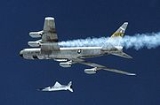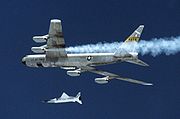
Air launch
Encyclopedia

Parasite aircraft
A parasite aircraft is a component of a composite aircraft which is carried, and air launched by, a mother ship aircraft.The first use for parasite aircraft was in 1916, when the British used a Bristol Scout, flying from a Felixstowe Porte Baby, a giant flying boat of its time. This eventually...
, rocket
Rocket
A rocket is a missile, spacecraft, aircraft or other vehicle which obtains thrust from a rocket engine. In all rockets, the exhaust is formed entirely from propellants carried within the rocket before use. Rocket engines work by action and reaction...
, or missile
Missile
Though a missile may be any thrown or launched object, it colloquially almost always refers to a self-propelled guided weapon system.-Etymology:The word missile comes from the Latin verb mittere, meaning "to send"...
from a mothership. The parasite aircraft or missile is usually tucked under the wing of the larger mothership and then "dropped" from underneath the wing while in flight. It may also be stored within a bomb bay, beneath the main body or even on the back of the carrier aircraft, as in the case of the D-21 drone. After release, the dropped craft or missile will then fire its own engines or rockets and propel away from the mothership. Air launching provides several advantages over launching from the ground, giving the smaller craft an altitude and range boost, while saving it the weight of the fuel and equipment needed to take off on its own.
History
One of the earliest uses of air launching used an airshipAirship
An airship or dirigible is a type of aerostat or "lighter-than-air aircraft" that can be steered and propelled through the air using rudders and propellers or other thrust mechanisms...
as a carrier and docking station for biplane
Biplane
A biplane is a fixed-wing aircraft with two superimposed main wings. The Wright brothers' Wright Flyer used a biplane design, as did most aircraft in the early years of aviation. While a biplane wing structure has a structural advantage, it produces more drag than a similar monoplane wing...
parasite fighters. These planes would connect to their mothership through a trapeze
Trapeze
A trapeze is a short horizontal bar hung by ropes or metal straps from a support. It is an aerial apparatus commonly found in circus performances...
-like rig, mounted to the top of the upper wing, that attached to a hook dangling from the bottom of the dirigible above. Fighters could be both launched and retrieved this way, giving the airship the speed and striking power of fixed-wing craft, while giving the fighters the range and lingering time of an airship. With advances in airplane technology, especially in range, the value of a dirigible mothership was reduced and the concept became obsolete. Nevertheless, the idea of lighter-than-air motherships for fleets of smaller aircraft remains romanticized in fiction today, in games such as Crimson Skies
Crimson Skies
Crimson Skies is a media franchise and fictional universe created by Jordan Weisman and Dave McCoy. The series' intellectual property is currently owned by Microsoft Game Studios , although Weisman's new company, Smith & Tinker Inc., has announced that it has licensed the electronic entertainment...
and Final Fantasy
Final Fantasy
is a media franchise created by Hironobu Sakaguchi, and is developed and owned by Square Enix . The franchise centers on a series of fantasy and science-fantasy role-playing video games , but includes motion pictures, anime, printed media, and other merchandise...
.
The parasite fighter concept was later revived several times, in an attempt to solve the problem of how to protect bombers from fighter attack. The Convair B-36
Convair B-36
The Convair B-36 "Peacemaker" was a strategic bomber built by Convair and operated solely by the United States Air Force from 1949 to 1959. The B-36 was the largest mass-produced piston engine aircraft ever made. It had the longest wingspan of any combat aircraft ever built , although there have...
was used to air launch several prototype fighters for defense, but none offered performance that could match ground-launched fighters — even the largest bomber ever mass-produced was too small a mothership for the jet age — and docking presented its own problems.
Air launch is mainly used for rocket-powered craft, allowing them to conserve their fuel until lifted to altitude by a larger aircraft. The B-52 Stratofortress and B-29 Superfortress
B-29 Superfortress
The B-29 Superfortress is a four-engine propeller-driven heavy bomber designed by Boeing that was flown primarily by the United States Air Forces in late-World War II and through the Korean War. The B-29 was one of the largest aircraft to see service during World War II...
have both served in the carrier role, most famously for the X-15 and Bell X-1
Bell X-1
The Bell X-1, originally designated XS-1, was a joint NACA-U.S. Army/US Air Force supersonic research project built by Bell Aircraft. Conceived in 1944 and designed and built over 1945, it eventually reached nearly 1,000 mph in 1948...
respectively.
The SR-71 program attempted to launch a Lockheed D-21/M-21
Lockheed D-21/M-21
The Lockheed D-21 was an American Mach 3+ reconnaissance drone. The D-21 was initially designed to be launched from the back of its M-21 carrier aircraft, a variant of the Lockheed A-12 aircraft. Development began in October 1962...
drone at Mach 3.2. This is potentially far more problematic and difficult due to the shock wave
Shock wave
A shock wave is a type of propagating disturbance. Like an ordinary wave, it carries energy and can propagate through a medium or in some cases in the absence of a material medium, through a field such as the electromagnetic field...
pattern around an aircraft at supersonic speeds. After three reasonably successful tests, the fourth attempt to do this caused the drone to crash into the mother ship and the accident led to the drowning of a crew member. The project was abandoned.
Recently, the air launch method has gained popularity in the fledgling civilian rocket world. The Ansari X-Prize $10 Million purse was won by a team led by Burt Rutan
Burt Rutan
Elbert Leander "Burt" Rutan is an American aerospace engineer noted for his originality in designing light, strong, unusual-looking, energy-efficient aircraft...
's Scaled Composites
Scaled Composites
Scaled Composites is an aerospace company founded by Burt Rutan and currently owned by Northrop Grumman that is located at the Mojave Spaceport, Mojave, California, United States...
, launching the SpaceShipOne from the purpose-built White Knight carrier aircraft. Another company, AirLaunch LLC
AirLaunch LLC
AirLaunch LLC was an aerospace design and development company headquartered in Kirkland, Washington. They hope to provide launch services for launching payloads into orbits around the Earth. This is to be realized through a method called air launch where a rocket is carried within an aircraft and...
is developing the QuickReach small satellite launch system, which will deploy a rocket in-flight from the cargo bay of an unmodified C-17
C-17 Globemaster III
The Boeing C-17 Globemaster III is a large military transport aircraft. Developed for the United States Air Force from the 1980s to the early 1990s by McDonnell Douglas, the C-17 is used for rapid strategic airlift of troops and cargo to main operating bases or forward operating bases throughout...
aircraft.
Most recently, the B-52 was used to launch the X-43 hypersonic testbed aircraft. The Pegasus rocket is an air launched orbital spacecraft, flown from a Lockheed L-1011
Lockheed L-1011
The Lockheed L-1011 TriStar, commonly referred to as the L-1011 or TriStar, is a medium-to-long range, widebody passenger trijet airliner. It was the third widebody airliner to enter commercial operations, following the Boeing 747 and the McDonnell Douglas DC-10. Between 1968 and 1984, Lockheed...
.
See also
- Parasite aircraftParasite aircraftA parasite aircraft is a component of a composite aircraft which is carried, and air launched by, a mother ship aircraft.The first use for parasite aircraft was in 1916, when the British used a Bristol Scout, flying from a Felixstowe Porte Baby, a giant flying boat of its time. This eventually...
- Composite aircraftComposite aircraftA composite aircraft is made up of multiple component craft. It takes off and flies initially as a single aircraft, with the components able to separate in flight and continue as independent aircraft.-Design principles:...
- Mother shipMother shipA mother ship is a vessel or aircraft that carries a smaller vessel or aircraft that operates independently from it. Examples include bombers converted to carry experimental aircraft to altitudes where they can conduct their research , or ships that carry small submarines to an area of ocean to be...
- Pegasus (rocket)
- Air launch to orbitAir launch to orbitAir launch to orbit is the method of launching rocket launch vehicles at altitude from a horizontal-takeoff turbojet aircraft, either subsonic or supersonic...
- Airborne aircraft carrierAirborne aircraft carrierAirborne aircraft carriers are aircraft which can launch other aircraft. These typically are large aircraft that launch fighter-interceptor planes.-Dirigible aircraft carriers:...

